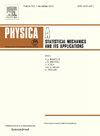Traffic dynamics in cooperative adaptive cruise control (CACC) vehicle platoons: Analyzing congestion and merge behaviors
IF 3.1
3区 物理与天体物理
Q2 PHYSICS, MULTIDISCIPLINARY
Physica A: Statistical Mechanics and its Applications
Pub Date : 2025-05-27
DOI:10.1016/j.physa.2025.130724
引用次数: 0
Abstract
This study investigates the platoon dynamics of Cooperative Adaptive Cruise Control (CACC)-equipped vehicles in mixed traffic environments, focusing on speed reduction, time-headway variations, and their effects on platoon stability. Simulations were conducted using aggressive, nominal, and cautious driver behavior models across mixed vehicle types, including trucks and small vehicles, with varying CACC ratios (20–80 %). Key performance indicators, such as time-headway, traffic density, and flow rate, were evaluated to examine the impact of CACC ratios on vehicular interaction during speed transitions, specifically from 120 kph to 100 kph and subsequent acceleration. Results demonstrated that higher CACC ratios facilitated smoother speed transitions and greater stability within the platoon. Additionally, position-based speed adjustments reduced traffic flow variability, particularly at high CACC ratios. Unlike prior studies, this research integrates a communication-based CACC control model, addressing lane-changing behaviors, vehicle communication, and realistic modeling of human-driven dynamics. The study also evaluates sliding mode control under mixed-traffic scenarios, emphasizing novel methodologies that address real-world constraints such as vehicle safety and physical limitations. These insights contribute to optimizing CACC configurations in mixed-traffic platoons, supporting enhanced cooperative driving strategies for congestion management and highway merging efficiency.
协同自适应巡航控制(CACC)车辆队列中的交通动力学:拥堵与合并行为分析
本文研究了混合交通环境下配备合作自适应巡航控制系统(Cooperative Adaptive Cruise Control, CACC)的车辆的队列动力学,重点研究了减速、车头时距变化及其对队列稳定性的影响。在混合车辆类型中,包括卡车和小型车辆,使用不同的CACC比率(20-80 %),使用激进、普通和谨慎的驾驶员行为模型进行了模拟。关键性能指标,如车头时距、交通密度和流量进行了评估,以检查在速度转换期间,特别是从120公里/小时到100公里/小时以及随后的加速期间,ccc比率对车辆相互作用的影响。结果表明,较高的CACC比率有助于更平稳的速度转换和更大的稳定性排。此外,基于位置的速度调整减少了交通流量的可变性,特别是在高ccac比率下。与之前的研究不同,本研究集成了基于通信的CACC控制模型,解决了变道行为、车辆通信和人类驱动动力学的现实建模。该研究还评估了混合交通场景下的滑模控制,强调了解决车辆安全和物理限制等现实约束的新方法。这些见解有助于优化混合交通队列中的CACC配置,支持增强的协作驾驶策略,以实现拥堵管理和高速公路合并效率。
本文章由计算机程序翻译,如有差异,请以英文原文为准。
求助全文
约1分钟内获得全文
求助全文
来源期刊
CiteScore
7.20
自引率
9.10%
发文量
852
审稿时长
6.6 months
期刊介绍:
Physica A: Statistical Mechanics and its Applications
Recognized by the European Physical Society
Physica A publishes research in the field of statistical mechanics and its applications.
Statistical mechanics sets out to explain the behaviour of macroscopic systems by studying the statistical properties of their microscopic constituents.
Applications of the techniques of statistical mechanics are widespread, and include: applications to physical systems such as solids, liquids and gases; applications to chemical and biological systems (colloids, interfaces, complex fluids, polymers and biopolymers, cell physics); and other interdisciplinary applications to for instance biological, economical and sociological systems.

 求助内容:
求助内容: 应助结果提醒方式:
应助结果提醒方式:


